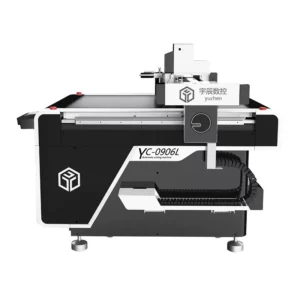Quality control checks in an automatic gasket cutting machine process are essential to ensure that produced gaskets meet the required standards for precision, accuracy, and overall quality. Integrating quality control checks involves a combination of technologies, sensors, and processes to monitor and verify various aspects of the gasket cutting process.
Here are common ways quality control is integrated into the automatic gasket cutting machine process:
- Computer-Aided Design (CAD) Inspection:
- Before the cutting process begins, CAD inspection is often used to verify that the gasket design matches the intended specifications. This ensures that the digital representation aligns with the actual cutting requirements.
- Material Inspection:
- Sensors or cameras may be used to inspect the raw material before cutting. This involves checking for material defects, irregularities, or variations in thickness that could impact the quality of the gaskets.
- Automatic Nesting Algorithms:
- Automatic nesting algorithms optimize the placement of gasket patterns on the material to reduce waste. These algorithms can also consider the material characteristics and identify potential issues such as overlaps or inefficient nesting that may affect the final product’s quality.
- Vision Systems for Pattern Recognition:
- Vision systems equipped with cameras are employed for pattern recognition. These systems can identify the outlines and features of gasket patterns, ensuring that they are accurately positioned on the material.
- Cutting Accuracy Monitoring:
- Real-time monitoring of the cutting process is essential to ensure cutting accuracy. Sensors or encoders on the cutting machine track the movement of the cutting tool, providing feedback on the precision and alignment of cuts.
- Edge Quality Inspection:
- After the cutting process, vision systems may be used to inspect the edges of the cut gaskets. This helps identify any irregularities,automatic gasket cutting machine burrs, or defects that could affect the gasket’s functionality or appearance.
- Dimensional Measurement Systems:
- Dimensional measurement systems, such as laser sensors or contact probes, can be employed to measure the dimensions of cut gaskets. This ensures that gaskets meet the specified tolerances and dimensions.
- Optical Character Recognition (OCR):
- OCR technology may be used to read and verify markings or labels on the gaskets. This is particularly important for gaskets with specific identification or labeling requirements.
- Automatic Sorting and Reject Systems:
- Automatic sorting systems are integrated to segregate gaskets based on quality. If a gasket is identified as defective during quality control checks, it can be automatically diverted for further inspection or marked as rejected.
- Data Logging and Traceability:
- Data logging systems record information related to each gasket produced, including cutting parameters, inspection results, and other relevant data. This facilitates traceability and helps identify trends or patterns in quality over time.
- Statistical Process Control (SPC):
- SPC techniques may be applied to monitor and control the gasket manufacturing process. Statistical analysis of key process parameters helps identify variations and ensures that the process remains within specified control limits.
- Operator Monitoring and Intervention:
- Operators may be equipped with tools to monitor the quality control process and intervene if necessary. Human inspection is valuable for identifying issues that automated systems may not catch, particularly those related to visual appearance.
- Regular Calibration and Maintenance:
- Regular calibration of sensors, cameras, and cutting tools is crucial for maintaining the accuracy and reliability of quality control systems. Additionally, routine maintenance ensures that the cutting machine operates optimally.
- Customer Feedback Integration:
- Feedback from customers or end-users can be integrated into the quality control process. This information helps identify any issues or concerns related to the performance of the gaskets in real-world applications.
By combining these quality control measures, manufacturers can achieve a high level of confidence in the accuracy, consistency, and overall quality of gaskets produced by automatic gasket cutting machines. Continuous monitoring, periodic audits, and a commitment to continuous improvement further enhance the effectiveness of quality control in gasket manufacturing processes.
